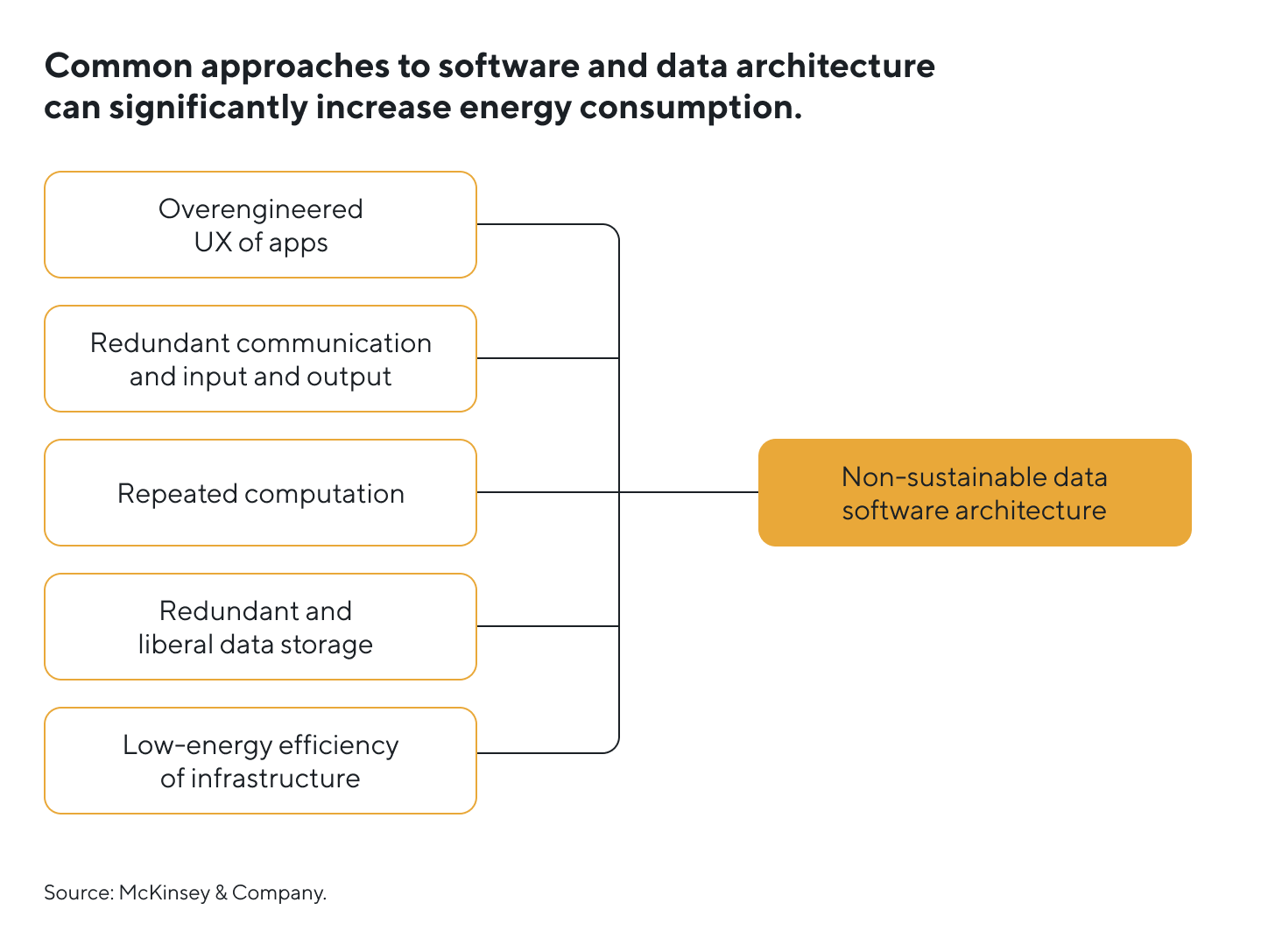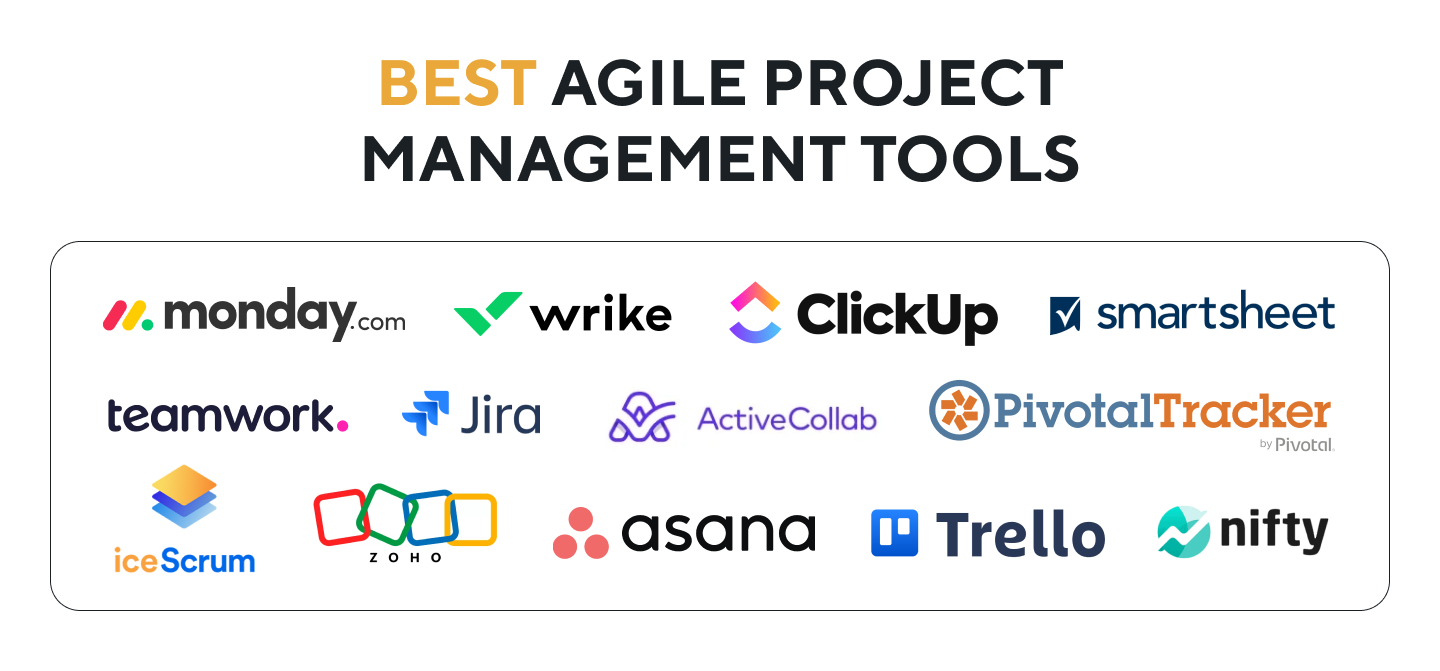As the world moves towards sustainable practices, we must consider how software development can contribute to a greener future. Sustainable software development principles are guidelines that help developers create applications that minimize their environmental impact. Yet, many companies still practice nonsustainable software architecture, increasing energy consumption and leading to unconscious software development. Let’s take a closer look at each of the principles, from carbon efficiency to reducing global digital energy consumption, and discuss their significance in creating eco-friendly software. By following these principles, we can offer mobile development that benefits the environment and improves our systems’ overall performance and efficiency.
Software and Data Become Ubiquitous
In the coming years, the proliferation of software and data will reach unprecedented levels. The ubiquity of these two intertwined entities has profoundly impacted our daily lives, businesses, and interactions with the world.
Not too long ago, software primarily existed on desktop computers. Today, it has spread to virtually every device we use. From smartphones and tablets to smart TVs, refrigerators, and even automobiles.
Software applications are no longer limited to productivity tools or entertainment. They have permeated every aspect of our lives. From healthcare and education to transportation and finance, there’s a software application for almost everything.
The proliferation of data is inseparable from the rise of software. Our interactions with software generate massive amounts of data daily. This data, often called “big data,” fuels machine learning algorithms, artificial intelligence, and data-driven decision-making. It has become a valuable resource for businesses and researchers alike.
The ubiquity of software and data has transformed traditional business models. Companies leverage data-driven insights to improve customer experiences, optimize supply chains, and develop innovative products and services. The digital age has given rise to new industries and disrupted established ones.

Source: McKinsey Company
Main Contributors to Software-Related Emissions
Several factors contribute to the software industry’s sizable carbon footprint, including:
Data centers:
Data centers, where vast amounts of digital information are hosted and processed, contribute significantly to software-related emissions. The energy-intensive operation of data centers and the increasing demand for cloud services exacerbate the environmental impact.
Energy consumption:
The energy consumption of software applications on various devices further exacerbates carbon emissions. As reliance on digital technologies grows, so does the energy consumption required to run them.
Software development practices:
Traditional software development practices often prioritize speed and functionality over environmental considerations. Inefficient coding practices, overuse of resources, and lack of optimization contribute to higher energy consumption and carbon emissions.
Sustainable Software Development Energy Efficiency Principles
Minimal Environmental Impact or Carbon Efficiency
Since digital technology operates in a non-physical environment, its carbon impact may seem unexpected. However, data processing needs a significant amount of CO2, which increases as digital data usage rises, and more energy is required to support our online data.
Carbon efficiency in software development refers to reducing software’s environmental impact throughout its lifecycle. It focuses on assessing and minimizing the software’s carbon footprint, aiming to mitigate the environmental effects of software development and usage.
Electricity Efficiency in the Software Industry
Understanding electricity efficiency in the software industry involves minimizing the energy consumption of software applications. It requires designing software with energy-efficient features to decrease electricity usage, thereby contributing to environmentally sustainable software solutions. By optimizing software for electricity efficiency, developers can improve the environmental impact of their applications and reduce overall energy consumption.
Electricity consumption directly influences the carbon intensity of software development, affecting its environmental footprint. Reducing energy consumption is crucial for reducing the carbon intensity associated with software development, as it directly impacts the carbon emissions produced per unit of electricity consumed. Implementing efficient algorithms and data structures is vital for developing energy-efficient applications.
Hardware Efficiency in the Context of Sustainable Software Development
Defining hardware efficiency involves using computing resources to minimize energy usage while maintaining high performance. This encompasses strategies aimed at reducing the environmental impact of software development. Sustainable software development integrates these strategies to improve hardware efficiency by optimizing resource utilization and minimizing energy consumption. By embracing hardware efficiency principles, developers can contribute to eco-friendly practices and ensure the next level of sustainable development.
Mindful design of applications with energy efficiency in mind is a crucial driver of hardware efficiency, representing a pivotal aspect of sustainable development practices. Optimizing algorithms and programming languages is critical in enhancing hardware efficiency within applications, contributing to more efficient use of computing resources, and supporting eco-friendly utilization of hardware resources.
Longevity as a Key Component of Sustainable Hardware
Considering a device’s lifespan during design is a key component of sustainable hardware. This calls for using durable materials, interchangeable parts, and readily repairable designs. We may minimize technological waste and lessen the need for frequent replacements by prolonging the lifespan of equipment.
Sustainability Through Measurement
Measurement in sustainable software development allows tracking the environmental impact of development activities. Accurate measurement offers insights into the carbon footprint, aiding in progress monitoring. It helps identify opportunities for reducing environmental impact and ensures software sustainability. Robust measurement practices are essential for sustainability.
Integrating measurement into the development process makes continuous enhancement of sustainable practices feasible. It allows for quantifying energy consumption and carbon emissions, driving next-level improvement in environmental performance.
Calculating Software Carbon Intensity

SCI = (E*I) + M per R
Functional Unit (R)- it is how software scales, for example, by user, device or API request
Energy consumption (E) – energy consumed by software, in kWh
Embodied carbon (M) – from the creation (and destruction of hardware that the software is running on
Location-Based Marginal Carbon Intensity (I) – carbon emitted per kWh of energy, in gCO2/kWh
Network Efficiency
Data transfers account for the majority of the industry’s energy use. The carbon emissions that result from these transfers depend on several variables:
- the size of the data,
- the distance it must travel,
- the number of network devices it must pass through,
- the energy efficiency of those devices,
- the carbon intensity of the local grids that power them.
Based on research Sustainable Web Design, let’s assume that 0.81 kWh is needed to transfer 1 GB of data. This indicates that transferring 1 GB of data results in emissions of 358 gCO₂eq, with a global carbon intensity of 442 gCO₂eq/kWh.
Network infrastructure’s energy efficiency is always improving. However, the amount of data keeps rising, which also causes emissions to climb. Eighty to ninety percent of all internet traffic comprises videos, and this tendency is predicted to continue. The amount of every content type on the internet is increasing, including photos, CSS, typefaces, and JavaScript.
Using well-established methods like HTTP caching, Content Delivery Networks (CDNs), minimizing and compressing JavaScript (JS) and CSS, optimizing and compressing images and videos, switching to SVG and WebP instead of other image formats, and only using images and videos that add value can significantly increase network efficiency and lower associated carbon emissions. For instance, you can drastically minimize image size by using monochrome or grayscale images instead of color images. In addition, images taken with a shallow depth of field and focused on the main subject might reduce their size by about 50%.
Specific strategies aim to prevent data transfers or shorten their distance, while others focus on minimizing the amount of data transferred. Reducing energy consumption on the end-user device is another advantage of some strategies, such as decreasing the use of JavaScript, which may lower those devices’ annual embodied carbon cost. Limiting the amount of data that needs to be exchanged might have a significant effect.
What Are the Best Practices for Sustainable Software Development?
Set Your Sustainable Goals
Establishing the definition of sustainability for your project and your metrics for measuring it is the first step towards developing software sustainably. You can use frameworks like the Sustainable Development Goals (SDGs), or the Green Software Engineering Principles can be used to help you make decisions and make sure your software complies with industry or international standards. As your software goes through its life cycle—from design to deployment—you should also foresee its effects on the environment, society, and economy.
Use Lean and Agile Tools
Agile and lean approaches prioritize iterative improvement, waste reduction, and user feedback and are ideal for sustainable software development. Retrospectives, Kanban boards, and user stories are examples of agile and lean tools that you may use to track and improve the functionality and quality of your product. Choosing the right tool is up to you and your team.
“Green Coding” Concept Into Practice
One concept that has gained traction in recent years is the idea of “green code.” Green code refers to designing and implementing software to reduce energy consumption and minimize environmental impact. This can involve
- optimizing code to run more efficiently,
- using renewable energy sources to power data centers,
- reducing unnecessary server usage,
- using effective data structures and algorithms, minimizing memory usage and garbage collection,
- cutting down on network traffic,
- routinely testing and debugging your code,
y embracing “green code” practices, we can make our technology more sustainable and contribute to a healthier planet.
Choose Modern Tools
The technologies you use to develop and run your software can significantly impact its sustainability. You can choose technologies compatible with sustainability goals, such as low-power devices, cloud-based services, or open-source software. We advise evaluating the trade-offs between different technologies, such as speed, scalability, reliability, and security. Simply use up-to-date tools that may pose risks or challenges for your software maintenance.

Key Elements of Sustainable Software Development: Summary
In recent years, the topic of sustainable development has gained more attention. There is a growing concern about the impact that humans are having on the environment and the need to take action towards reducing our carbon footprint. In the software industry, it is no different. The adoption of sustainable practices in software development is becoming increasingly important to reduce energy consumption and waste production and create better products for consumers. We offer to check vital efforts developers can take to build sustainable digital products:
- Carbon Efficiency: Reducing the carbon footprint of software throughout its lifecycle.
- Electricity Efficiency: Designing software with energy-efficient features to decrease electricity usage.
- Hardware Efficiency: Responsible use of computing resources to minimize energy usage while maintaining high performance.
- Network Efficiency: Strategies to reduce carbon emissions related to data transfers.
- Measurement for Sustainability: Tracking the environmental impact and identifying opportunities for improvement.
- Sustainable Goals: Defining sustainability metrics and considering environmental, societal, and economic effects.
- Lean and Agile Tools: Prioritizing iterative improvement, waste reduction, and user feedback.
- “Green Coding” Concept: Designing software to reduce energy consumption and environmental impact.
- Choosing Modern Tools: Selecting technologies compatible with sustainability goals.
Sustainable software development is a practical and cost-effective way to create environmentally friendly and efficient software for a greener future.



